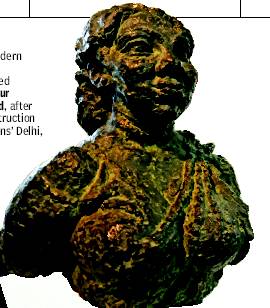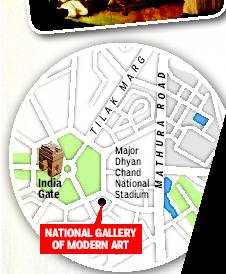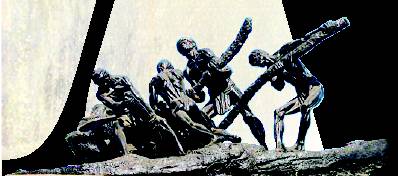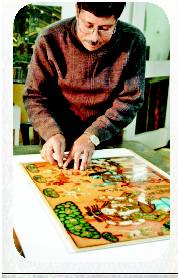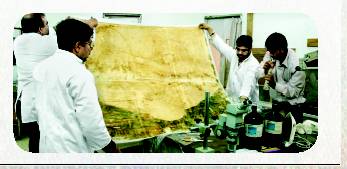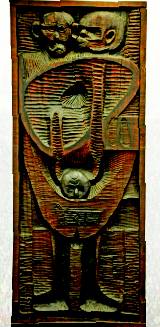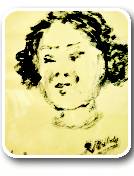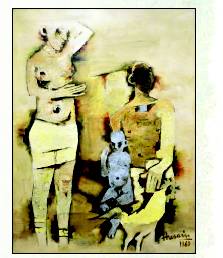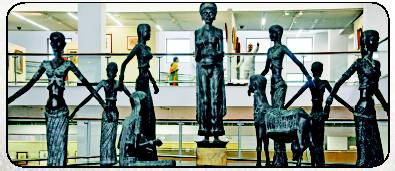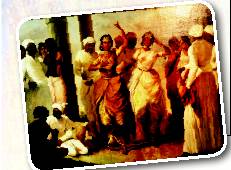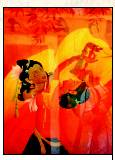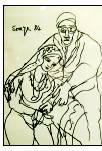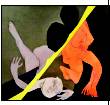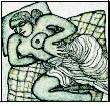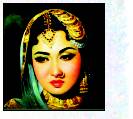National Gallery of Modern Art (NGMA) , India
Contents |
National Gallery of Modern Art (NGMA)
Title and authorship of the original article(s)
|
National Gallery of Modern Art By Jayashree Nandi , The Times of India , 2013/04/28 |
This is a newspaper article selected for the excellence of its content. |
NGMA not only has the most up-to-date collection of Indian art since the 1850s but also opens a window on its present station in the world and future direction
For all the secrecy and security with which the consignment was offloaded from the flight from Paris and then rushed to the portals of the National Gallery of Modern Art (NGMA) in thermostatic containers, it could have been a cask of plutonium. But it was something far more valuable, culturally—a set of Picasso’s works sent for an exhibition to the NGMA, straight from the Musse National Picasso in Paris. The gallery had to worry about not only theft but also damage due to mishandling.
Secrecy is very much a part of the NGMA’s high-profile operations, and there’s a touch of adventure even in its seemingly mundane activities like acquisitions. For instance, the gallery acquired a Subodh Gupta artwork for Rs 1 lakh in 2004. Unthinkable, considering that his works cost at least a few crores each. Even the late M F Husain gave his works to the NGMA at nearly half the going rate.
As the largest repository of modern art in the country, NGMA acquires works from all prominent Indian artists through a purchase committee set up by the ministry of culture which includes art historians, artists and other distinguished persons. NGMA first decides which artists suit its collection. The purchase committee then shortlists works that can be acquired at a reasonable price. “The work has to be reasonable enough to be acquired by a government museum. After several screenings and negotiations we arrive at a decision,” says NGMA director Rajeev Lochan.
Since NGMA is a national institution, many artists voluntarily give it their works. “There is no point discussing the commercial value of these paintings. They are just art of the nation when they are in NGMA,” says Lochan. Over the years, NGMA has acquired works of all the Indian masters, from Rabindranath Tagore to Amrita Sher-Gil and Tyeb Mehta, making it one of the most glorious and expensive collections in the world. However, the process of maintaining the museum is far from simple.
NGMA organizes exhibitions celebrating each artist in its collection. Each exhibition involves sourcing other important works of the artist from various museums and repositories across the world. The process starts with convincing a collector about lending the required work. If the piece is a work of national importance in another country, the government of India and the foreign government have to agree upon its insured value. An agreement is also signed between the collectors giving the ‘publication rights’ for the exhibition.
But it requires persistence and negotiation skills to get a collector to lend a work. “Sometimes it takes over a year to convince the collector about lending the works for an exhibition,” says Lochan. Similarly, when a museum wants to take works from NGMA’s collection, the National Screening and Evaluation Committee (NSEC) evaluates the works that are to be lent. An all-risk ‘wall-to-wall’ insurance coverage has to be ensured for all loans as per values decided by NSEC. The highest quality safety measures have to be in place for any such transaction, which means a grind for the staff.
Once NGMA has the works, it has to focus on logistics. When Anish Kapoor’s installations were brought to the gallery, they had to be constantly kept in thermostatic trucks to avoid damage. The permanent collection at NGMA too needs contant monitoring. “Any artwork has to be kept n a controlled environment in terms of light and humidity. It can neiher be left in very dark urroundings nor a very bright ambience. The humidity too has to be optimum. We routinely check every work for onset of damage. And even if a work requires restoration it’s important to avoid tampering with the original,” says Satyendra Kumar Gupta, consultant for exhibitions.
Even during exhibitions, the staff is careful about the kind of illumination used. For an oil painting, it’s around 60 lux (unit of light intensity), for water colours it can be around 40 lux and for miniatures with minute details it’s about 35 lux.
The work doesn’t end there. Expert curators have to decide on a display strategy. For instance, when NGMA organized an exhibition on Tagore’s paintings called ‘The Last Harvest’ there were unforeseen hurdles. Tagore did not name his paintings and drawings, nor did he date them. He also believed that “they came to him like foundlings, thus they do not readily lend themselves to be arranged chronologically or stylistically”. The curators had to arrange the exhibition thematically, reflecting four important thematic foci of his work. The arrangement of the paintings had to be such that “one does not need to leave the flow of circulation and move across the room space to view exhibits on opposite walls and break the viewing sequence,” reads the exhibition concept note.
Lochan’s passion for art reflects in his contempt for the general perception of museums. “People think it’s a warehouse where relics from the past are kept. But I can tell you that it’s the only place which houses history in its reality.” The staff doesn’t mind the technical formalities of maintaining the museum either. Art works inspire them every day”.
At the end of a guided tour of the museum one is left with the intensity of Amrita Sher-Gil’s self-portrait, the vibrancy of Tyeb Mehta’s colours or a memory of MF Husain’s racing horses. The actual remains invisible.
RESTORATION
NGMA has undertaken numerous restoration projects over the years. One of the most important is the restoration of a bird painting by Rabindranath Tagore. He used ordinary paper to paint and over a long period of time the paper had become extremely fragile. The restoration involved consolidating the paint layer, mending the tears and holes in the paper and providing support for strengthening the paper. Another challenging project was taken up to restore the paper work of Jogen Chowdhary which was pasted on a ply board. It had to be carefully removed from the board before it could be restored
1857 ONWARDS
Indian miniatures, Company-style paintings, Kalighat and Tanjore paintings, academic realists like Raja Ravi Varma and those trained in the British art schools like M F Pithawala, Pestonjee Bomonjee and Hemen Majumdar
EARLY 20TH CENTURY ONWARDS
Bengal School of Art which countered the academic realists, represented by Abanindranath Tagore, M A R Chugtai, Kshitindra Majumdar and others. Shantiniketan artists like Nandalal Bose, Ramkinkar Baij and Benod Behari Mukherjee. The four most celebrated modern artists in this phase were Rabindranath Tagore, Gaganendranath Tagore, Amrita Sher-Gil and Jamini Roy
1940 ONWARDS
The Progressive Artists Group in Mumbai showed a spirit of dissent and freedom in its works. S H Raza described the group that wished to “look at the world from an Indian way, not a British way”. Prominent artists of the time were M F Husain, F N Souza, K H Ara, S H Raza and the Calcutta Group with Gopal Ghose, Paritosh Sen and Prodosh Das Gupta
1950-70
Rise of Indian abstract art with Tyeb Mehta, Satish Gujral, Akbar Padamsee, V S Gaitonde, A Ramachandran, among others
1960-80
Ganesh Pyne, Rameshwar Broota, Jogen Chowdhury, among others
1980 ONWARDS
Experiments with new methods and materials. Themes like gender, environment and urban crisis began to surface in works. Dominated by Sudhir Patwardhan, Manjit Bawa, Rameshwar Broota, Jatin Das, Anjolie Ela Menon, Arpana Caur, Rekha Rodwittiya, Atul Dodiya, Subodh Gupta, among others
Arpana Caur
Bandeep Singh , Memory as metaphor , “India Today” 14/11/2016
MOST POPULAR
Works of Rabindranath Tagore, M F Husain, Tyeb Mehta, F N Souza, Amrita Sher-Gil, S H Raza and Subodh Gupta
Portraits of heroines like Meena Kumari, Nargis and Madhubala by Balakrishna Arts in the popular section
Modern contemporary section with pieces on modern themes like environment and urban issues
